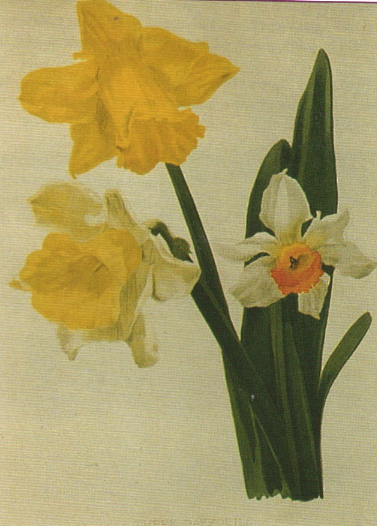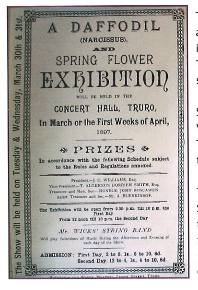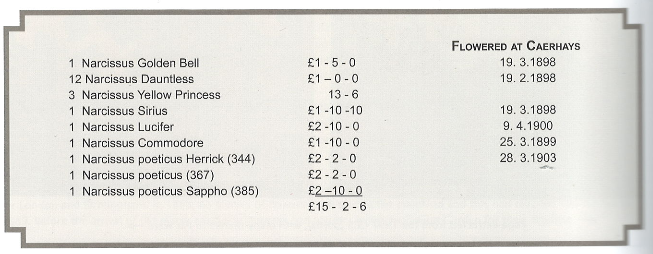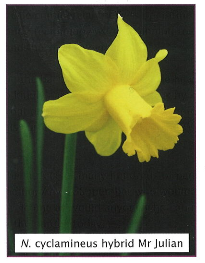Originally published in The Journal of the Cornwall Garden Society No. 58 February 2015
In his retirement, and probably in an attempt to stave off the onset of the dreaded Alzheimer’s, my father spent many years researching the garden archive records at Caerhays with the intention of publishing a series of articles about the history of the garden. The first of these articles, setting the scene, was published in the 1997 CGS Journal but much more subsequent analysis of the work of other growers and breeders working in similar fields at the time has helped build up a much more detailed and interesting picture of my great-grandfather, J.C. Williams (1861-1939) contribution to specific areas of horticulture. To prevent all this effort being wasted, and because only a very few people can decipher my father’s writing, I have tried to reproduce here a brief synopsis of what would merit a whole book on daffodil breeders over the last 100 years.
In the early 19th Century the production of new daffodil hybrids depended upon professional nurserymen and florists; principally Barr & Co and Messrs Leeds and Backhouse who were breeding wild collected daffodil species from Europe. Dean Herbert challenges this attitude in an 1847 article which draws attention to ‘the infinite variety of Narcissus that can be raised – hybridisation work offers small gardener hybridisers a source of harmless interesting amusement and perhaps a little profit and celebrity’.
The Reverend George Engleheart (1851-1936) went to Appleshaw near Andover in 1881 and started his life long devotion to breeding daffodils. He was the first great amateur producing hundreds of named varieties and a great number of daffodils which received awards from the RHS. Later he moved to Dinton in Hampshire where he continued his work until 1923 ‘when his bulbs were attacked by eelworm and fly so that he decided to part with his whole stock’.
Through the pioneering efforts of Algernon Dorrien-Smith daffodils had been introduced to the Scilly Isles and then had produced an alternative crop for the smallholders on the islands. In 1883 he had visited the Channel Islands, Belgium and Holland where daffodil flowering was at least a month later than on Tresco. Dorrien-Smith therefore thought it safe to buy quantities of daffodil bulbs for himself and his tenants.
The railway had arrived at Penzance and soon a great many boxes of daffodils were seen leaving Penzance railway station for London and Birmingham. In 1885 65 tonnes of flowers were sent to the mainland and this had reached 198 tonnes in 1889. Before the arrival of the motor car the Scillonians had speedy access to Covent Garden for their produce.
 ‘
‘Monarch’, ‘Weardale Perfection’ and ‘Lulworth’. JC Williams won the prize for the finest bloom at the first Truro daffodil show in 1897 with a ‘beautiful specimen’ of ‘Weardale Perfection’. Illustration from The Garden 1899.
It seemed obvious that if the Scillonians could grow daffodils then the small growers of West, Central and East Cornwall could do so as well. Cornwall had seen the collapse of its mining industry in the second half of the 19th Century and daffodil growing provided one answer to the problem of unemployment.
In 1885 flower shows began to be held on Scilly. With the growing interest in daffodils the next big development for this new industry was the flower show where breeders and small growers could show off their new varieties and their commercial potential to encourage farmers to try another crop.
 The first Truro Daffodil Show was held in March 1897. Its President was J.C. Williams and Vice President Algernon Dorrien-Smith. The chief organisers for the first show and its successors until the coming of the First World War was The Hon. John Boscawen of Tregye and it was his drive and enthusiasm which ensured the growing value of the show both to the growers and to the public.
The first Truro Daffodil Show was held in March 1897. Its President was J.C. Williams and Vice President Algernon Dorrien-Smith. The chief organisers for the first show and its successors until the coming of the First World War was The Hon. John Boscawen of Tregye and it was his drive and enthusiasm which ensured the growing value of the show both to the growers and to the public.
Spring flower shows soon also appeared at Penzance, Falmouth and, finally, the Tamar Valley Show which held its displays in various venues from Launceston to Plymouth. The first two shows still thrive and continue today although daffodils may no longer be the dominant theme.
The growing realisation of the importance of the work of the Cornwall Daffodil and Spring Flower Show Committee and what they were really trying to do comes across in the report the Gardeners Chronicle on the 1899 show. The presence of a delegation from the RHS including the secretary and the Reverend Engleheart shows that the powers that be at the centre of horticulture wanted to see what was going on in Cornwall.
At the opening ceremony J.C. Williams thanked the delegation for coming such a long way and told them that there presence was meant to encourage “what was in train, namely the advancement of a worthy and profitable industry in Cornwall”.
In reply the Reverend Engleheart told his audience to beware “of making their show a matter of fashion and amusement. The show was to be a sign of and an incentive to active work; namely the furthering of this great industry in the county and it would go on from things already good to things even worthier”. As good a sales pitch for his own breeding work as one could possibly imagine!
Cornwall was not the only place where show fever was occurring outside London. 1899 saw the first Midland Daffodil Show which was held in the Edgbaston Botanic Gardens. The President was the Rt. Hon. Joseph Chamberlain MP and among the vice presidents was J.C. Williams. Both J.C. Williams and his cousin P.D. Williams of Lanarth exhibited on this occasion and P.D. Williams was to go on to become President of the Society.
J.C. Williams began growing daffodils in 1893 but his interest really took hold after the first Truro Show in 1897 where The Reverend Engleheart was a judge. On 5th April 1897 J.C. Williams and his lifelong friend, P.D. Williams visited Appleshaw and both made significant purchase from Engleheart.

Shortly after their visit JCW purchased ‘a whole bed’ of 2 year old daffodil seedlings from Engleheart. Sadly there is no record of the cost but the above may give a fair indication of its enormity.
JCW started his leather bound garden book with whole pages devoted to each day of the year on 1st January 1897. It contains 1,650 diary entries in JCW’s own handwriting up to 1934. In 1898 the book records ‘new’ daffodil ground in ‘electric light field’ (today called Kennel Close and Tin Garden alongside the building housing the estate’s first electric supply). “Two year olds in new ground 7,000, over 2,000 in lower ground”. On 30th January 1898 is the entry “I made my first cross, minor with soleil d’or”.
The ‘Engleheart bed’ is recorded in detail with new numbers attributed to the seedlings by JCW alongside the Engleheart numbers. Three of JCW’s handwritten books describe the progress of his purchases with his own grading system. One must remember that daffodil seedlings can, and usually do, take several years to flower.
Number 126
Two bulbs (1898) a fine red tubed flower a rich scarlet when first open, it seems to be strong CALL IT CARDINAL
Open on April 4th faded a bit
July 1898 moved 4 bulbs discarded one of them – Book I
A nice white rim eye. Swells in water. 1908. xxx ½. A pretty eyed bicolor March 6th 1913 – Book II
A pretty eyed bicolor xxx ½ 1913 – Book III
Frustratingly there is little detail of the names of the original purchases between 1895 and 1907 although many were of course as yet unnamed seedlings. A list of the Engleheart purchases in so far as these can be gleaned from the garden planting out records is however attached as Appendix 1.
Equally frustrating is that JCW very seldom named his own hybrids and, to the annoyance of journalists and growers alike, he only exhibited his work with numbers. This was also to become a feature of JCW’s hybridisation work with rhododendrons and camellias where the majority of his new creations were named only after his death or by others. To understand JCW’s reticence one has to understand his detestation of all publicity about the garden at Caerhays and his desire to remain low profile and unostentatious. In part it was also because daffodil breeding (like all plant breeding) was very hit or miss, subject to eelworm and other diseases, and because a variety with a pretty new flower might not have the ability to divide and reproduce quickly enough for commercial growing. JCW clearly hugely enjoyed his daffodil breeding and it provided solace from the death of his sons in The Great War but he was happy to leave the naming and trialling for field growing to others. In any event, by 1905, his interests were turning from daffodils to the new wealth of Chinese plant material arriving at Caerhays and Werrington from the great plant explorers, Wilson and Forrest.
The purchaser of any of JCW’s numbered hybrids would reproduce the plant and, if it was thought to be good enough, it was then shown to the RHS Daffodil Committee for an award or to the Royal Bulb Growers Society in Holland in Haarlem. An award gave added value to the successful variety and brought it to the attention of a wider public.
There are however two key exceptions:-
1. N. Horace
This was raised by Engleheart (pre 1894) as ornatus x n. radiiflorus. In 1898 JCW writes that he purchased the entire stock of ‘Horace’. Alex Wilson, a keen hybridist, writing in the 1939 Daffodil Year Book sated ‘The greatest thrill I ever received over a flower was on 7th April 1907 in the Old Drill Hall when going around a corner I saw Horace for the first time. Horace in these days was the most distinct and refined poeticus yet seen. I remember trying to buy the stock of it was told it was not for sale’.
By 1907 it appears that part of the stock of Horace was growing on Tresco. Major Arthur Dorrien-Smith wrote to PDW on 16th April 1919 “11,718 bunches of this variety were sent to Covent Garden and George Monro returned a cheque for £811-7-0”. Perhaps this figure could be multiplied by 40 or 50 times to give some indication today of the monetary success of this shipment.
2. N. Croesus
This was bred by JCW pre 1912. It received an FCC from the RHS in 1922 and AM’s in Haarlem in 1914 and 1933.
Alex Wilson, again writing in the 1939 Yearbook, states that he bought the entire stock of N. Croesus from JCW in 1909 for £100. The ‘entire stock’ consisted of nine bulbs. He goes on to say that he sold over £2,000 worth of it before he gave up growing it yet in 1939 Croesus still rates very highly as a variety for pots or bowls, as a variety for forcing for market and as a variety for garden decoration. However by 1949 the variety is no longer mentioned.
Alex Wilson found that the value of his stock of daffodils in the 1920’s had been reduced from £12,000 (a figure accepted by the Inland Revenue at the time) to £200 by an attack of eelworm. Daffodil growers took great risks before the arrival of chemicals and perhaps Croesus was a casualty.
A list of daffodil hybrids bred by JCW is attached as Appendix 2.
It is very difficult to follow JCW’s daffodil crossing over the years. Records do exist but their correct interpretation cannot be guaranteed. JCW continued to hybridise daffodils until 1929 but is interest waned, certainly after 1914.
Therefore, in assessing JCW’s real contribution to daffodil breeding one has to look to the work of other breeders who visited Caerhays regularly and to those more modern new varieties whose parentage can be traced directly back to JCW’s own hybrids.
It would appear that the people most interested in the work that JCW was doing with the daffodils and who before the War were purchasing or obtaining his new seedlings were:-
1. The Reverend Engleheart visited Caerhays every year from 1897 – 1914 and on through the 1920’s even after his own collection was abandoned. PDW was nearly always present.
2. His brother-in-law Sir Charles Cave of Sidbury Manor, also visited Caerhays every year during the flowering season between 1899 and 1914. The 1992 Daffodil Register shows over 140 of his seedlings were registered although the first ones seem to have been known in 1907 – he did not receive awards from the RHS Daffodil Committee for his efforts until 1917 with an AM Queen of Dawn.
3. Next was Charles Dawson. According to PDW’s daughter Lavender he was in a local bank board at Penzance with PDW and that she remembered him because he had a wooden leg. Neither pieces of information have been confirmed. What is known that he came to stay Caerhays at Daffodil Time between 1902 – 1906 and his address is given as Rosemorran, Gulval. It looks likely that he moved away from Cornwall after 1906.
4. Dawson’s place seems to have been taken by Alex M. Wilson. First of Shovell, Somerset and then he moved to Presteigne in Radnorshire where he continued his daffodil interest and one of his most successful acquisitions of a breeding daffodil was N. Hospodar which he purchased from Caerhays.
Another complication is how Caerhays seedlings found their way around the country, is in the arrival of a new Truro Nurseryman, J.C. Martin, who received a Silver Banksian medal at the 1913 Truro Show and an award of merit for his N. Silver Penny. The most famous hybrid from this nursery was Silver Chimes which achieved great popularity over a long period.
J. Martin’s father was almost certainly Gardener Martin, the Head Gardener of Caerhays, who remained in this position until the mid 1920’s.
It would appear that JCW recorded about 5,500 daffodil crosses during his lifetime. Of these 43 are still attributed to his breeding in the 1998 Daffodil Yearbook. How many have died out it is impossible to say. However, working from the same register in this yearbook, the parentage of over 1,100 of the varieties listed can be traced directly back to JCW’s crosses. To this list can perhaps be added a few hundred others where the exact parentage is unclear (possibly deliberately in such a large scale competitive business) but very probably can be traced back to Caerhays breeding. JCW’s desire for anonymity has not therefore been entirely successful when one digs deeper.
N. ‘Hospodar’ (JCW 1914 ‘Firebrand’ x ‘King Alfred’) is a good case in point. A.M. Wilson tells the amazing story that he gave seed of Hospodar x his own seedlings to a Miss G.C. Evelyn. This one box of seedlings produced:-
N. Caerleon AM 1935
N. Diolite AM 1932 AM (H) 1938
N. Marksman AM 1933 FCC 1949
N. Russom Pasha AM1949 FCC 1954
The influence of N. Hospodar can be traced through to N. Ceyla (J.L. Richardson pre 1943) which was a cross of Marshsman x Dolite which received its first award (Preliminary Commendation 1945) to its most recent award AGM. (Award of Garden Merit) which it received in 1945.
Although science certainly comes into breeding and will certainly also enter the process from time to time it should also be remembered that the one of the parents of Hospodar was Princess Mary bred by E. Leeds pre 1877 and which received an FCC 1884.
The wide breeding influence of N. Hospodar can be sharpened:-
N. Whitely Gem bred by Broche of Broda circa 1934
Hospodar x Fortune – received many Awards of Merit
N. Flamenco bred by J.L. Richards pre 1935
Hospodar x Sunstar – FCC 1952
N. Saltash bred by P.D. Williams (Lanarth) pre 1933
Hospodar Hybrid – PC 1948
N. Garibaldi bred by A.M. Wilson pre 1931
Hospodar seeding No. 491 – AM 1931
N. Krakatoa bred by J.L Richardson pre 1937
Garibaldi x Fortune – AM 1945 – FCC Haarlem 1955
One anecdote in N. Krakatoa seems to be in order.
This daffodil was considered important and had to be preserved at all costs. Matthew Zandbergen sent my grandfather, A.M. Williams of Werrington Park, 4 bulbs of it which he had to invoice for £100 per bulb.
At the time of the German Blitz in Plymouth, bombs appeared to fall fairly close to them. The most important thing apparently, above life and limb, was the safety of these bulbs and my grandparents rushed with torches to see if they were safe. The offending bombs had in fact fallen in a field a mile way.
J.C. Williams achievements in daffodil breeding cannot be compared to those of his cousin P.D. Williams and his son Michael Williams whose 1949 catalogue complete with prices is reproduced in part as Appendix 3. Nor can they be compared to the two great Irish hybridists, Guy Wilson and J. Lionel Richardson. The former indulged his pursuit of new varieties from 1906-1962 and the latter from 1911-1961. Sadly by the late 1950’s large scale commercial growers operating in different parts of the world and with new farming technology were beginning to overrun and destroy the Cornish daffodil industry and the small breeder.
 When my father was researching the background of this article he was in regular touch for advice with Ron Scamp who kindly named a N. cyclamineus hybrid ‘Mr Julian’. It grows splendidly outside the front door. It is perhaps fitting therefore to include a list of Ron’s hybrids which are in his current catalogue which have JCW’s breeding in their parentage (Appendix 4).
When my father was researching the background of this article he was in regular touch for advice with Ron Scamp who kindly named a N. cyclamineus hybrid ‘Mr Julian’. It grows splendidly outside the front door. It is perhaps fitting therefore to include a list of Ron’s hybrids which are in his current catalogue which have JCW’s breeding in their parentage (Appendix 4).
This article merely scratches the surface of many hundreds of pages of my father’s research work on daffodil breeding. Any CGS member who would like to consult more of the source material is very welcome as would anyone who can name more of the old varieties still flourishing in the garden today.
Charles Williams
June 2014
APPENDIX I
Daffodils Purchased from Engleheart for Caerhays and Lanarth 1897 – pre 1907
2 Sirius PDW – JCW
3 Lucifer PDW – JCW AM 1898
4 Sol GHE 1902
13 Virgil GHE 1902 AM 1900
21 Albatross GHE 1901 FCC 1894
22 Seagull GHE 1902
38 Torch GHE 1901 AM 1902
40 Dorothy Yorke Pre 1903
41 Resolute Pre 1903
44 White Lady AM 1898
47 Commodore Pre 1907
52 Ceres GHE 1902
62 Oriflamme AM 1898
71 Golden Bell FCC 1892
75 Lettice Harmer AM 1897
84 No Name
93 Peach GHE 1901
101 Dauntless JCW – PDW
140 Ariadine GHE 1901 AM 1905
148 Electra GHE 1901
150 No Name
156 Water Witch GHE 1901
160 Egeria GHE 1901
192 Phyllis GHE 1901
228 Pole Star GHE 1902
232 Amber GHE 1901 AM 1901
242 Florence GHE 1902 AM 1901
290 Golden Princess
333 Ben Jonson
335 Dante FCC 1894
344 Herrick AM 1901
347 Cassandra AM 1899
348 Lovelace
350 Laura
361 Tasso
362 Sir Walter Scott
366 Horace AM 1914
367 Chaucer GHE 1902
368 Homer FCC 1898
369 Arno GHE 1902
385 Sappho
464 Comus GHE 1901-1902
466 Edil GHE 1902
480 Siren GHE 1902 JCW
481 Firebrand GHE 1901-1902 JCW
552 Artemis
619 No Name
628 Siren
637 Warrior GHE 1902
638 Alma GHE 1902 AM 1900
681 Arsent GHE 1902
689 Strongbow GHE 1902 AM 1899
836 Golden Cup GHE 1902
APPENDIX 2
Daffodils bred by J.C. Williams
(Taken from International Daffodil Register and Classified List 1998)
32 Adamant Pre 1945 AM 1952 FCC 1953
61 Andromeda Pre 1908
79 Arlington Pre 1945
102 Baltic Pre 1945
103 Bandicoot Pre 1910
108 Bartley Pre 1934 AM 1946 FCC 1949 AM 1981
114 Bedouin Pre 1908 AM(Haarlem) 1912 AM(G/C) 1914
115 Beeswax Pre 1945
145 Bramble Pre 1945
167 Caligula Pre 1908
199 Charm Pre 1908
250 Crescendo Pre 1945 AM(G) 1952
252 Croesus Pre 1912 FCC 1912 AM (Haarlem) 1914 AM(G) 1914
FA (Haarlem) 1933
281 Dido Pre 1930 Seedling 764
295 Dragoon Pre 1913
364 Fleetwing Pre 1907
367 Florinda Pre 1931 Syn. Goldelse
385 Gadfly Pre 1910
412 Glorious Pre 1923 AM(C/G) 1923 AM (Haarlem) 1926
FCC (C/M) 1926 Kirton (H/C (G/M) 1922
Kirton AM (G/M) 1934 AM (G) 1936
422 Golden King Pre 1913
431 Goldilocks Pre 1937
485 Hospodar Pre 1914 Firebrand x King Alfred (C/G) 1936
490 Hypatia Pre 1910
625 Magician Pre 1927
666 Midas Pre 1913
727 Noontide Pre 1945
751 Osprey 1925
777 Pepper Pre 1933 (maximus x Firebrand) AM (M) 1935
787 Picture Pre 1945
808 Polvarth Pre 1949
832 Puritan Pre 1910
848 Red Beacon Pre 1910
849 Red Chick Pre 1909
894 Rubellite Pre 1912
923 Sealing Wax Pre 1912
1010 Syphax Pre 1914 King Alfred x Jonquilla AM(G/C) 1914
1015 Tamerlane &
